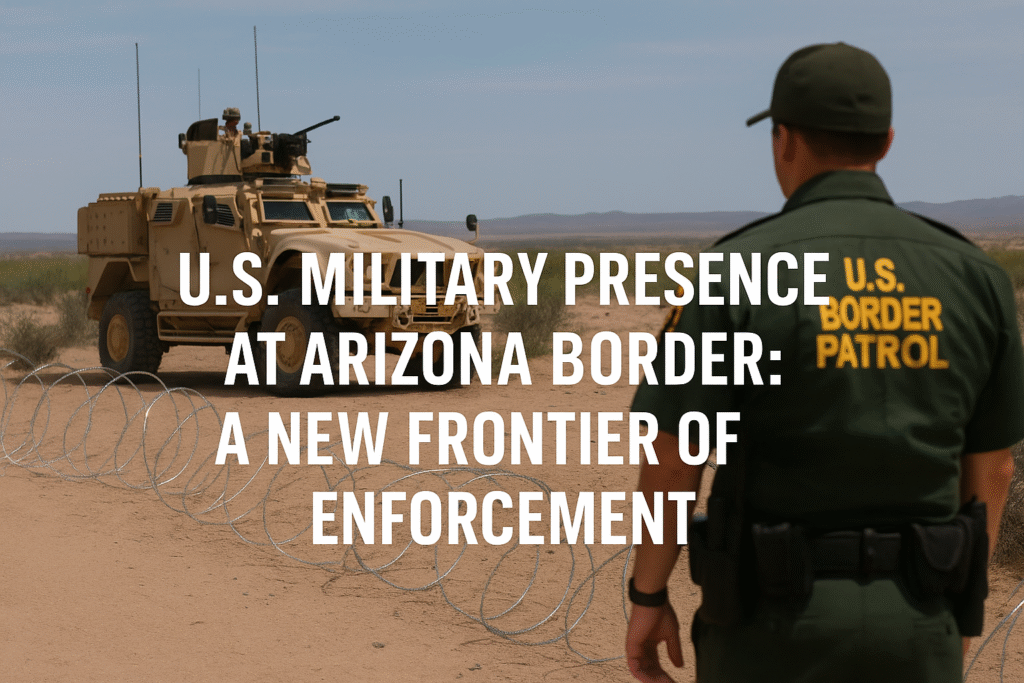U.S. Military Presence at Arizona Border: A New Frontier of Enforcement

Introduction
The Arizona‑Mexico border has quieted over recent months—illegal crossings have dropped to historic lows. Yet, today, a growing military footprint looms large. Troops, armored vehicles, drones, fortified zones… Why is this happening when encounters are down? And what’s next for this controversial mission?
Background: The Military Steps In
Back in April 2025, a presidential order granted the U.S. military control over the Roosevelt Reservation—a narrow federal strip along the entire southern border, including Arizona. Now, any migrant crossing that zone risks being classified as a trespasser on military property.
This move effectively placed the Department of Defense in direct control of border enforcement duties traditionally reserved for civilian authorities.
The Active Deployment: What’s Happening Now
- Multiple National Defense Areas created: The Arizona zone stretches roughly 140 miles near Yuma, tied to Marine Corps Air Station Yuma and the Barry M. Goldwater Air Force Range.
- Troops on the ground: Around 7,600 military personnel from all branches now work alongside Border Patrol in Arizona—triple the troop levels seen previously.
- Surveillance and vehicles: Stryker armored vehicles, MRAPs, helicopters, drones and concertina wire are deployed to monitor and deter remote crossings.
- Command center established: A remote command hub in southern Arizona coordinates troop movements, surveillance, and rapid responses.
Why Now?
Despite migrant encounters hitting a 60‑year low, officials argue vigilance is still needed. Cartel tactics have shifted—tunnels, remote desert routes, and nighttime crossings are the new norm. The military presence is meant to dissuade “got‑aways” who slip past Border Patrol undetected.
Proponents also cite the surging fentanyl crisis originating from Mexico. Military infrastructure is seen as a way to slow drug trafficking and disrupt smuggling networks.
Reactions & Human Fallout
Interpretations vary—and emotions run high. Supporters describe the deployment as necessary for national security. But critics warn: This level of military involvement blurs the lines between defense and domestic enforcement, potentially violating long‑standing legal limits.
Tehran natives and Indigenous communities have voiced distress. With much of Arizona tribal land excluded from militarized zones, migrants are funneled into hazardous terrain. Advocates fear more deaths in deserts and mountains as safe passage narrows.
What It Means for Arizona
Local law enforcement officials—a mix of relief and concern. While Army reconnaissance aids situational awareness, there’s fear people in distress will avoid calling 911, worried calls trigger immigration actions instead of rescue.
Environmental advocates add another dimension: armored patrols and increased traffic are damaging fragile Sonoran Desert ecosystems. Native plant species and endangered wildlife face disruption.
What Comes Next?
- Expanding defense zones: Additional federal land may be transferred, creating new buffer areas under military oversight.
- Legal challenges looming: Civil liberties groups could challenge the arrangement as unconstitutional—especially use of active-duty troops in enforcement.
- Political debate intensifies: Spring 2026 elections will spotlight this strategy. Will lawmakers push back—or double down?
- Shift to tech-based surveillance: As borders quiet further, the emphasis may shift to drones and remote sensors, reducing boots-on-ground presence.
Conclusion
A once‑quiet desert border is now a theater of military strategy. With troops, drones, and armored vehicles marking the landscape, the question isn’t just who’s crossing—it’s what it means for the balance between security, law, and humanity.
As policy shapes itself around this new reality, local communities, human rights advocates, and lawmakers must ask: Is this enhanced presence a step toward protection—or a dangerous overreach?